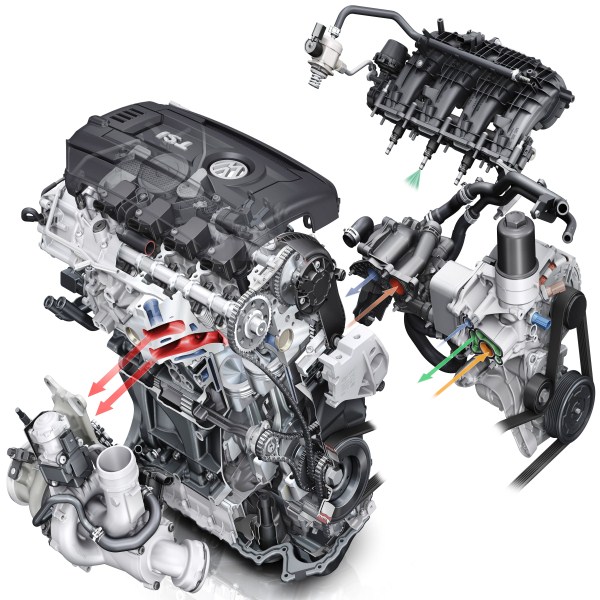
While the practise of integrating the runners of an exhaust manifold into a cylinder head is not exactly new, Volkswagen has managed to eliminate many of the problems that come with this approach to engine design. For instance, on the ubiquitous AE888 engine, Volkswagen engineers have managed not only to make exhaust runners that all have the same length and volume; they have also managed to cool the exhaust runners uniformly. This article will briefly discuss the advantages of the integrated, water-cooled exhaust manifold on VW’s AE888 engine, starting with this question-
While at first glance, the increased complexity of the cylinder head casting process might appear to offset any possible advantages in terms of reducing manufacturing and assembly costs, the fact is that when the number of AE888 engines VW produces is considered, the advantages in terms of increased engine efficiency and reductions in weight far outweigh any possible disadvantages. Below is a quick rundown of the advantages of an integrated exhaust manifold as they apply to the AE888 engine-
Reduced thermal stresses on the engine
As experienced technicians, we all know that exhaust manifold gaskets can develop leaks for no apparent reason. However, the principal reason why these gaskets start to leak is the fact that the cast iron exhaust manifolds are made of and the aluminium cylinder heads are made of expand and contract at vastly different rates. Over time, the lateral movements caused by the different expansion rates between the cylinder head and the exhaust manifold cause the gasket to fail, and on some applications, the exhaust manifold to warp as well.
Thus, by integrating the exhaust manifold into the cylinder head, the problems that come with the different thermal properties of disparate materials are greatly reduced, if not eliminated altogether.
Reduced turbo lag
Since the turbo charger bolts directly onto the cylinder head, the distance that the exhaust gas has to travel to reach the turbo charger is greatly reduced. A secondary effect is that since there is no exhaust manifold with a relatively large volume, the density and pressure of the exhaust gas is not affected before it reaches the turbo charger. Collectively, these two factors decrease turbo charger spool-up times significantly, with the added bonus that throttle response is greatly improved.
Decreased engine warm-up times
Since combustion is very inefficient at low temperatures, having the exhaust manifold inside the cylinder head greatly reduces the time required to bring the engine up to a temperature where combustion becomes efficient enough for the ECU to reduce the injector pulse width to more economical levels, which results in measurable fuel savings over extended periods.
As a corollary, the reduced surface area of the engine means that less heat is lost to the engine compartment, which means that not only can the passenger cabin be heated faster, but also that the A/C system is more efficient because of the reduced heat in the engine compartment.
In addition to the above, reduced engine warm-up times mean that the engine oil is also heated up sooner in low temperatures, with both improved lubrication in low ambient temperatures and prolonged engine life as a result.
Reduced catalytic converter warm-up times
Since catalytic converters only start to work when they reach their optimum operating temperatures, having the exhaust gas reach the converter sooner means that the converter’s core heats up faster, thereby reducing emissions measurably, since it enters closed loop operation faster.
Increased catalytic converter durability
Even though exhaust gas sheds a significant amount of heat through a conventional exhaust manifold, operating an engine at high loads and speeds for an extended period can cause the exhaust gas to heat up to the point where the catalytic converters’ core can be damaged, or even be destroyed.
Traditionally, ECU’s managed the exhaust gas temperature by enriching the air/fuel mixture to reduce the exhaust gas temperature to acceptable levels. However, by cooling the exhaust gas inside the cylinder head the exhaust gas never reaches dangerously high temperatures, which translates into not only increased catalytic converter durability, but significant improvements in fuel economy as well.
As a practical matter, the exhaust gas temperature is reduced by around 800C in the cylinder head, which is sufficient not to require the ECU to enrich the air/fuel mixture in order to control the exhaust gas temperature. According to official VW sources, this fact translates into fuel savings of up to 20% during highway cruising conditions.
More space in the engine compartment
While having more space in the engine compartment is unlikely to a big thing in the life of the average car buyer, engineers might translate that additional space into larger passenger cabins, which is major selling point from the perspective of buyers of compact cars.
However, as attractive as more legroom in the passenger compartment might be for the average car owner, having more space in the engine compartment is a major boon to mechanics everywhere.
Based on the cumulative experience of car manufacturers that have adopted integrated exhaust manifolds as a design philosophy, the only tangible, objective disadvantage of the design is that it places an additional load on the engine cooling system.
However, while Volkswagen has not released any technical information on the improvements their engineers have made to the cooling system of the AE888 engine, it would be reasonable to assume that they have at least-